A solid sphere of uniform density and radius 4 units is located with its centre at the origin O of coordinates.Two spheres of equal radii 1 unit with their centres at A –2 0 0 and B 2 0 0 respectively are taken out of the solid leaving behind spherical cavities as shown in figure thena the gravitational force due to this object at the origin is zerob the gravitational force at point B2 0 0 is zeroc the gravitational potential is same at all points of the circle y2 + z2 = 36 d both a and c
Correct option d both a and cExplanation: Since the two spheres are of same size and symmetrically placed w.r.t. O their gravitational force on O will be equal and opposite therefore the net force at O is zero. y 2 + z2 = 36 is a circle of radius 6 cm. This circle lies outside the sphere. Thus potential at each point of it is same. Hence the correct option is d.
Related Solutions
A solid sphere of uniform density and radius 4 units is located with its centre at the origin O of coordinates. Two sphere of equal radii 1 unit, with their centres at A(-2,0 ,0) and B(2,0,0) respectively, are taken out of the solid leaving behind spherical cavities as shown if fig Then:
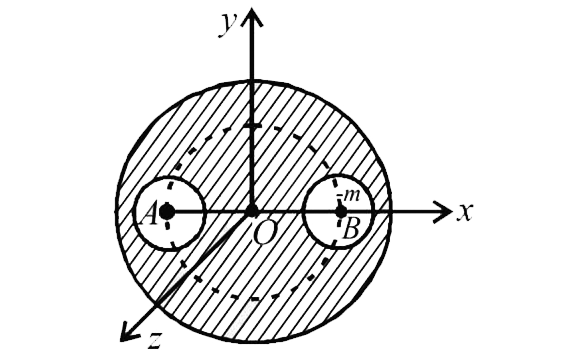
View SolutionA solid sphere of uniform density and radius 4 units is located with its centre at the origin O of coordinates. Two sphere of equal radii 1 unit, with their centres at A(-2,0 ,0) and B(2,0,0) respectively, are taken out of the solid leaving behind spherical cavities as shown if fig Then:

View SolutionA solid sphere of uniform density and radius 4 units is located with its centre at the origin O of coordinates. Two sphere of equal radii 1 unit, with their centres at A(-2,0 ,0) and B(2,0,0) respectively, are taken out of the solid leaving behind spherical cavities as shown if fig Then:
View SolutionA solid sphere of uniform density and radius 4 units is located with its centre at the origin O of coordinates. Two sphere of equal radii 1 unit, with their centres at A(-2,0 ,0) and B(2,0,0) respectively, are taken out of the solid leaving behind spherical cavities as shown if fig Then:

View SolutionA solid sphere of uniform density and radius 4 units is located with its centre at the origin O of coordinates. Two sphere of equal radii 1 unit, with their centres at A(-2,0 ,0) and B(2,0,0) respectively, are taken out of the solid leaving behind spherical cavities as shown if fig Then: The gravitational field due to this object at the orgin is zero. The gravitational force at point B(2, 0, 0) is zero. The gravitational force at point B(2, 0, 0) is zero. Both (1) & (3)
View SolutionA solid sphere of uniform density and radius 4 units is located with its centre at the origin of coordinates, O. Two spheres of equal radii of 1 unit, with their centres at A (-2,0,0) and B(2,0,0) respectively, are taken out of the solid sphere, leaving behind spherical cavities as shown in the figure
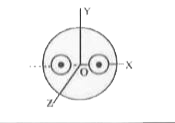
a) The gravitational force due to this object at the origin is zero
b) The gravitational force at the point B(2,0,0) is zero
c) The gravitational potential is the same at all points of the circle d) The gravitational potential is the same at all points on the circle
View SolutionA solid sphere of uniform density and radius 4 units is located with its centre at the origin of coordinates , O. Two spheres of equal radii of 1 unit with their centres at A (-2,0,0) and B(2,0,0) respectively , are taken out of the solid sphere , leaving behind spherical cavities as shown in the figure .

(a)The gravitational force due to this object at the origin is zero
(b) The gravitational force at the point B(2,0,0) is zero
(c) The gravitational potential is the same at all points of the circle
(d)The gravitational potential is the same at all points on the circle
View SolutionA solid sphere of uniform density and radius 4 units is located with its centre at the origin of coordinates, O. Two spheres of equal radii of 1 unit, with their centres at A (-2,0,0) and B(2,0,0) respectively, are taken out of the solid sphere, leaving behind spherical cavities as shown in the figure
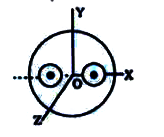
(a) The gravitational force due to this object at the origin is zero
(b) The gravitational force at the point B(2,0,0) is zero
(c) The gravitational potential is the same at all points of the circle
(d) The gravitational potential is the same at all points on the circle
View SolutionA solid sphere of uniform density and radius 4 units is located with its centre at the origin of coordinates, O. Two spheres of equal radii of 1 unit, with their centres at A (-2,0,0) and B(2,0,0) respectively, are taken out of the solid sphere, leaving behind spherical cavities as shown in the figure (a) The gravitational force due to this object at the origin is zero (b) The gravitational force at the point B(2,0,0) is zero (c) The gravitational potential is the same at all points of the circle y^(2) + z^(2) = 36 (d) The gravitational potential is the same at all points on the circle y^(2) + z^(2) = 4
View SolutionA solid sphere of uniform density and mass M has radius 4m its centre is at the origin of the coordinate system two spheres of radii 1m are taken out so that their centres are at P(0,-2,0) and Q(0,2,0) respectively this leaves two spherical cavities what is the gravitational field at the centre of the cavities
View SolutionA solid sphere of uniform density and radius 4 units is located with its centre at the origin O of coordinates. Two sphere of equal radii 1 unit, with their centres at A(-2,0 ,0) and B(2,0,0) respectively, are taken out of the solid leaving behind spherical cavities as shown if fig Then:

View SolutionA solid sphere of uniform density and radius 4 units is located with its centre of at the origin O of co ordinates. Two spheres of equal radii 1 unit with their centres at A(-2,0,0) and B(2,0,0) respectively are taken ou of the solid leaving behind spherical cavities as shown in figure. Then which of the following statements are true? (a) The gravitational force due to this object at the origin is zero. (b) The gravitational force at the point B(2,0,0) is zero. The gravitational potential is the same at all points on the circle y^(2)+Z^(2)=36 (d) The gravitational potential is the same at all points on the circle y^(2)+Z^(2)=4
View Solutionચાર એકમ ત્રિજ્યા અને નિયમિત ઘનતા ધરાવતા એક ઘન ગોળા પરના ઉગમબિંદુ O પર તેના કેન્દ્ર સાથે આવેલો છે. 1 એકમ સમાન ત્રિજ્યા ધરાવતા બે ગોળાઓ અનુક્રમે A(-2, 0, 0) અને B(2, 0, 0) પર આવેલા છે. તેઓને ગોળામાંથી બહાર લઈ આકૃતિ મુજબ પાછળ બખોલને રાખતાં ........

View SolutionConsider a solid sphere of density and radius . Centre of the sphere is at origin. Two spherical cavities centred at and are created in sphere. Radii of both cavities is . In left cavity material of density is filled while second cavity is kept empty. What is gravitational field at origin.
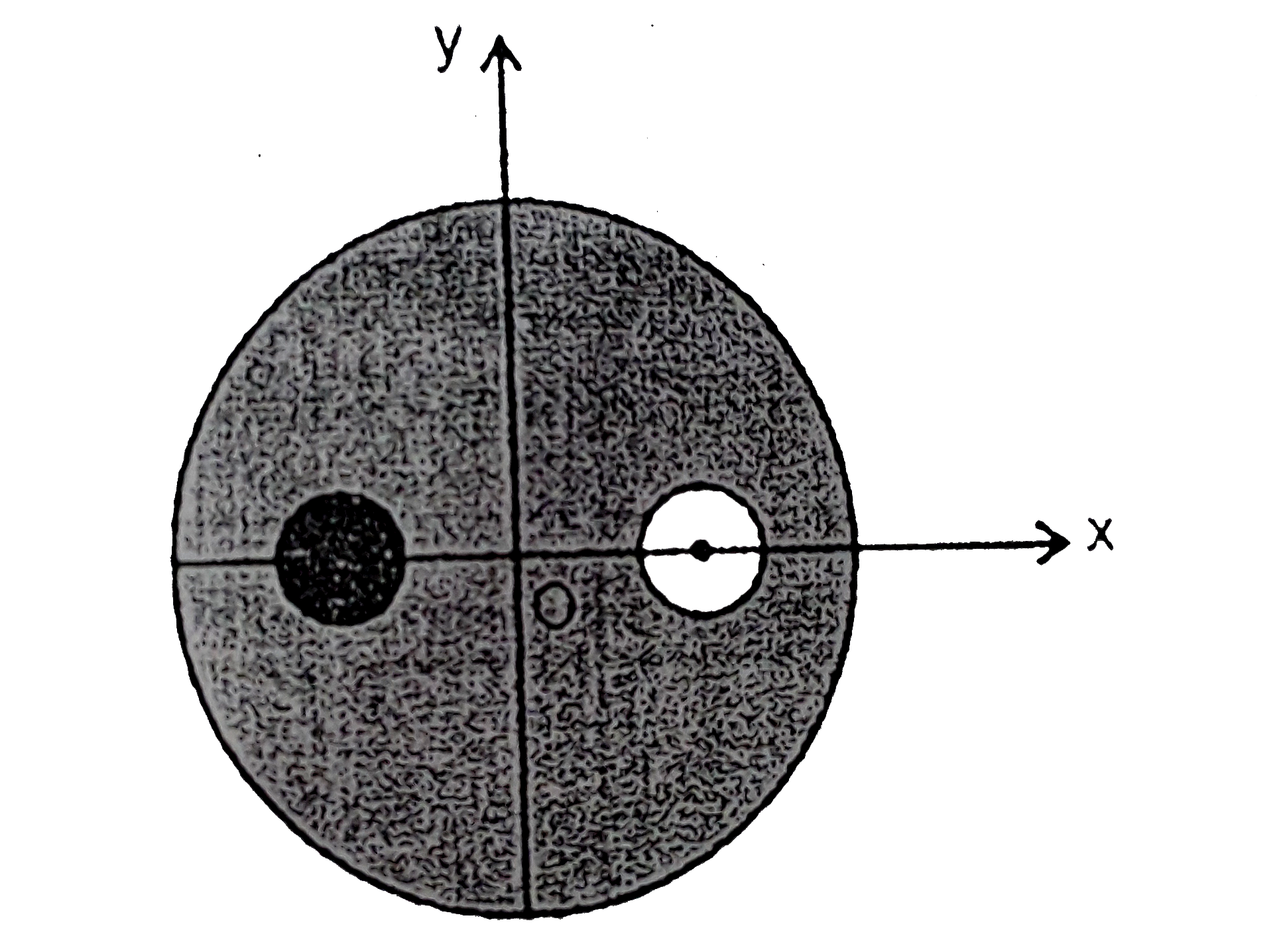
View SolutionConsider a solid sphere of density rho and radius 4R . Centre of the sphere is at origin. Two spherical cavities centred at (2R,0) and (-2R,0) are created in sphere. Radii of both cavities is R . In left cavity material of density 2rho is filled while second cavity is kept empty. What is gravitational field at origin.
View Solutionएकसमान घनत्व तथा 4 मात्रक त्रिज्या के एक ठोस गोले का केंद्र मूलबिंदु O पर है। प्रत्येक 1 मात्रक त्रिज्या के दो गोले, जिनके केंद्र क्रमश: A(-2, 0, 0) तथा B(2, 0, 0) पर हैं, ठोस में से निकाल लिये गये हैं तथा उनके स्थानों पर गोलीय कोश रह जाते हैं, तब

View SolutionA spherical cavity is formed a solid sphere by removing mass from it. The resultant configuration is shown in figure. Find out the moment of inertia this configuration about the axis through centre of the solid sphere as shown . Take mass uniform for the configuration and radius for solid sphere and radius for cavity.
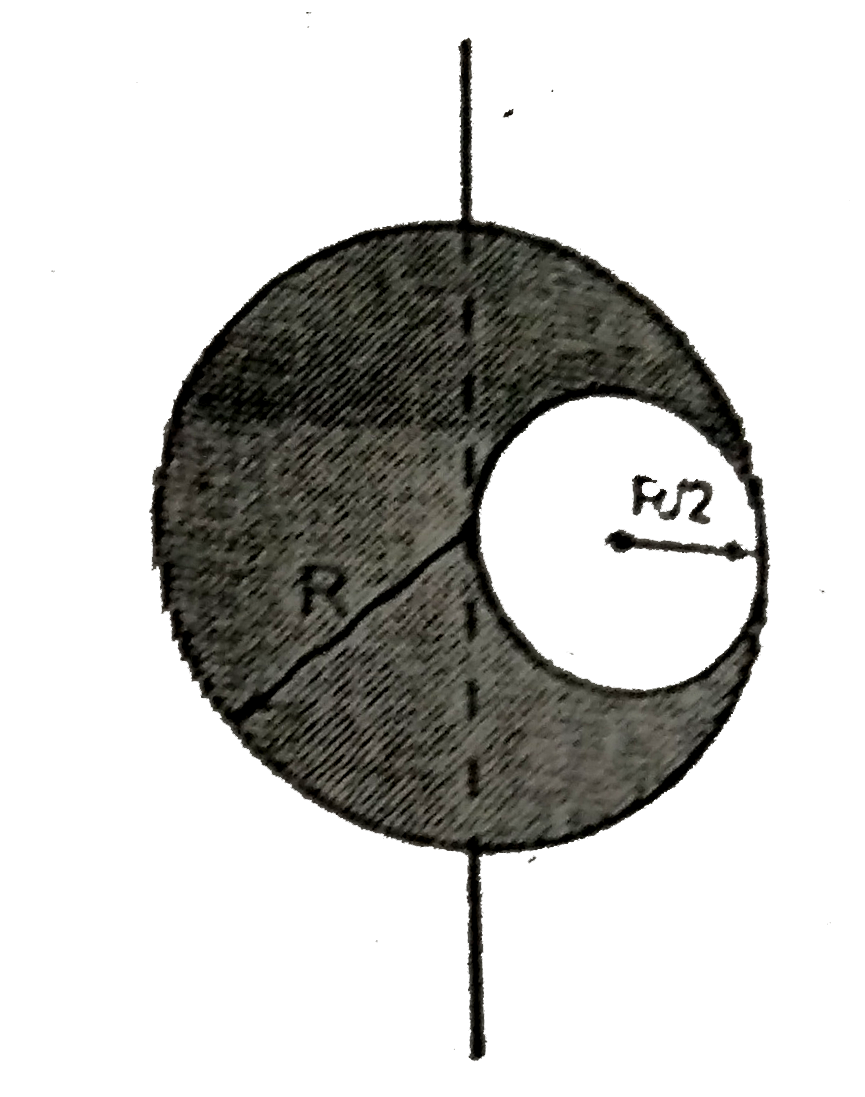
View SolutionA fixed sphere of radius R and uniform density rho has a spherical cavity of radius R//2 such that the surface of the cavity passes through the centre of the sphere. A particle of mass m is located at the centre (A) of the velocity. Calculated (a) The gravitational field at A . (b) The velocity with which the particle strikes the centre O of the sphere. (Neglect earth's gravity)
View SolutionA non conducting sphere of radius a is charged uniform with volume charge density rho . There is a spherical cavity in the sphere with radius b. The position vector of centre of the cavity with respect to centre of the original sphere is vecC . Find the electric field at any point inside the cavity whose position vector is vecr with respect to centre of the original sphere.
View SolutionA solid sphere of mass M and radius R has a spherical cavity of radius R/2 such that the centre of cavity is at a distance R/2 from the centre of the sphere. A point mass m is placed inside the cavity at a distanace R/4 from the centre of sphere. The gravitational force on mass m is
View Solution